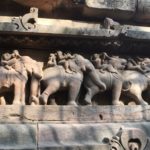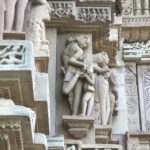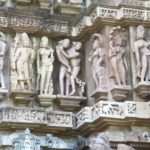Jaipur to Khajuraho – 656 km (train)
& 7791 Fit Bit Steps
We had pleasant and interesting company for the first part of our 13 hour train journey to Khujuraho. Adam is originally from Texas, but presently lives in Berlin. He is a travel writer and blogger, his blog targetted at hipsters and the gay community. Alex, a Costa Rican also living in Berlin is doing a PhD on the effect of tourism on European cities, specifically Amsterdam, Venice and Barcelona.
From Agra, where Adam and Alex left us, we travelled southeast through farmlands of winter wheat and mustard (seed used for cooking oil), interspersed with rocky outcrops, often marked by ruined forts.
Khajuraho is the site of a group of magnificent Hindu and Jain temples built between 939 AD and 1050 by rulers of the Chandela Dynasty. Of the 85 temples constructed, 25 remain, these having been abandoned and protected by jungle overgrowth until rediscovered in the 19th C by a British officer under the guidance of local villagers. Dedicated to Shiva, Vishnu and other Hindu Gods, the temples are said to commemorate important events, including victories over rivals. In addition to the architectural beauty of the buildings themselves, the temples are known for their exquisite temple art, believed to be among the best in the world. On the outsides of the temples are friezes of finely carved stone sculptures of gods, goddesses, warriors, musicians, dancers and real and mythological animals. Many of the sculptures are representation of female beauty, depicted in everyday scenes such as a woman removing a thorn from her foot, another applying eye makeup, one doing a handstand, another writing a letter or cuddling a baby. A number of the panels illustrate gods engaging in playfully erotic activities, some of which involve animals.
Khajuraho is one of the four holy sites linked to deity Shiva. It has been proposed that the temples’ origin reflect the Hindu mythology in which Khajuraho is the place where Shiva got married.
Each block of stone was sculpted off-site and all pieces of the very large temples were assembled with mortise and tenon joints and no mortar. A top keystone holds the structure together. The structures are remarkably straight and true and must have required very precise planning and sculpting, particularly as the figures are all different and never repeated. The UNESCO World Heritage designation is deserved.
An evening sound and light show provided a creative historical overview of the creation of the temples.
Our accommodation at the elegant Lalit Temple View Hotel was a welcome treat!












